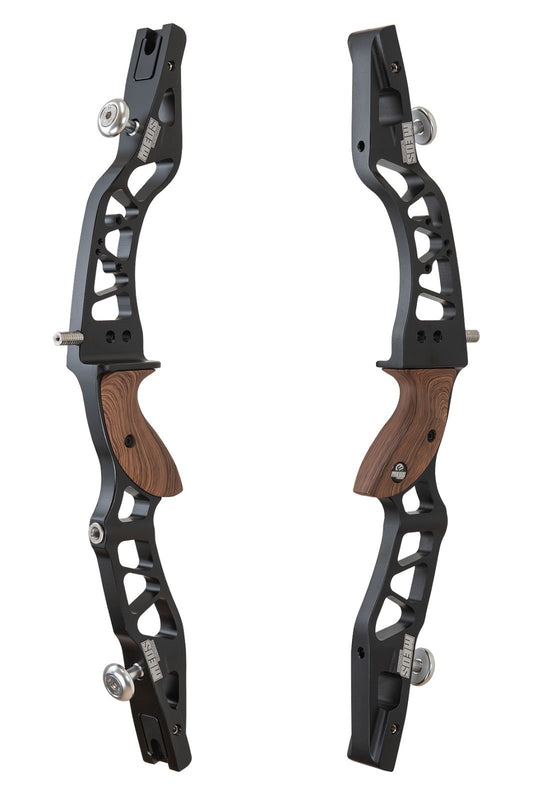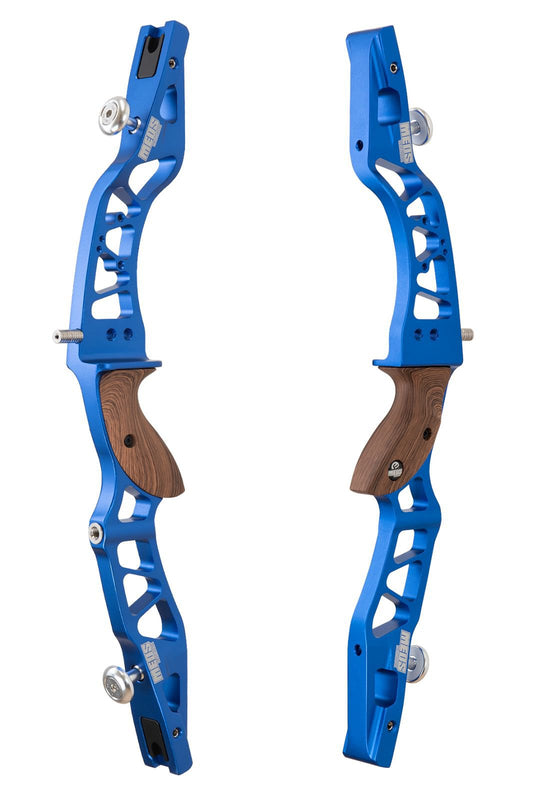-
Kinetic Meos 21" Handle ILF
Vendor:KineticRegular price £114.95 GBPRegular priceUnit price per
What to know more about archery
What is a recurve bow
A recurve bow is a type of bow that has limbs which curve away from the archer when unstrung. This distinct shape provides more power and efficiency than a straight-limbed bow of the same length, making it ideal for situations where compactness and power are needed.
Key Features of a Recurve Bow:
- Curved Limbs: The limbs curve outward at the ends, giving the bow its distinctive "recurve" shape.
- More Power in Shorter Size: The recurve design allows the bow to store more energy and deliver more speed to the arrow with a shorter overall bow length.
- Used in Various Disciplines: Recurve bows are used in modern Olympic archery, traditional archery, and sometimes bowhunting.
- No Wheels or Pulleys: Unlike compound bows, which use a system of pulleys and cables, recurve bows rely entirely on the strength and flexibility of the limbs.
- Requires Skill: Without mechanical aids like sights or stabilizers (unless added), shooting a recurve bow requires good technique, making it a popular choice for traditionalists.
The bow is favored for its simplicity, versatility, and historical use, tracing back to ancient civilizations like the Mongols and Greeks.
What is a compound bow
A compound bow is a modern type of bow that uses a system of pulleys (cams) and cables to bend the limbs. This mechanical advantage allows archers to hold less weight at full draw compared to traditional bows like recurves, making it easier to aim and hold the bow steady.
Key Features of a Compound Bow:
- Cams and Pulleys: The defining feature of a compound bow is its system of eccentric cams or wheels that multiply the force exerted by the archer, making the bow more efficient and powerful.
- Let-Off: At full draw, the cams reduce the holding weight (called "let-off"), so the archer holds a fraction of the draw weight. For example, a 70-pound draw weight with 80% let-off would require the archer to hold only 14 pounds at full draw. This allows for steadier aiming.
- Stiffer Limbs: Compound bows have very stiff limbs that are connected by the cam system. This adds durability and allows for more energy to be stored in the bow.
- Adjustability: The draw weight and draw length can usually be adjusted to fit the archer's needs, making the compound bow customizable and versatile.
- Faster Arrow Speed: Compound bows generate more kinetic energy, which results in faster arrow speeds compared to traditional bows.
- Accessories: Archers often use sights, stabilizers, arrow rests, and release aids with compound bows, enhancing accuracy and consistency.
Advantages of a Compound Bow:
- Power and Speed: Compound bows can shoot arrows at higher speeds due to their efficient energy transfer.
- Precision and Accuracy: The let-off makes it easier to aim, and the addition of sights and stabilizers improves precision.
- Customizability: You can fine-tune the bow's draw weight, draw length, and accessories to suit your shooting style.
Use Cases:
- Hunting: Compound bows are popular among bowhunters because of their power, speed, and accuracy.
- Target Shooting: Many archers use compound bows for competitive target shooting due to their stability and precision.
What is a longbow
A longbow is a tall, traditional bow with a simple, straight design that lacks the recurve of modern bows. It’s known for its simplicity, historical significance, and effectiveness in archery, especially during medieval times.
Key Features of a Longbow:
- Straight, D-Shaped Design: The longbow has a simple, straight stave and a classic D-shaped cross-section when viewed from the side. The limbs remain straight even when the bow is unstrung.
- Height: Longbows are typically as tall as, or taller than, the archer—often around 6 feet or more. This long length allows for a smooth, even draw.
- No Mechanical Parts: Unlike compound bows, longbows have no cams, pulleys, or mechanical aids. It’s a purely manual bow, requiring more skill and strength from the archer.
- Historical Significance: The longbow has deep roots in history, especially during the Middle Ages when it was used by English archers in battles like Agincourt. It was the weapon of choice for many cultures, including Welsh and English armies.
- Wood Construction: Traditionally, longbows are made from a single piece of wood (often yew or ash), but modern versions may incorporate laminated layers of wood and other materials.
Characteristics:
- Smooth Draw: The longer length provides a smooth, even draw and can store a significant amount of energy for shooting arrows.
- Requires Strength: Longbows can have heavy draw weights (sometimes exceeding 100 pounds in historical war bows), requiring the archer to develop physical strength.
- Lower Arrow Speed: Longbows typically shoot arrows at a lower speed than compound or recurve bows due to their simple design and lack of mechanical aids.
Advantages of a Longbow:
- Simplicity: No complicated mechanisms, just the archer, the bow, and the arrow.
- Quiet Shot: Longbows are generally quieter when released, which is why some traditional hunters prefer them.
- Durability: Being made from a single piece of wood (or laminated layers), longbows are quite durable when cared for properly.
Disadvantages:
- Requires Skill: Since longbows lack modern aids like sights or stabilizers, they require a high degree of skill, practice, and strength to shoot accurately.
- Slower Arrow Speed: Compared to compound or recurve bows, longbows generally produce slower arrow speeds, which can be less advantageous for hunting or long-distance shooting.
Use Cases:
- Historical Archery: Archers interested in historical reenactments, traditional archery, or medieval weaponry often choose longbows.
- Traditional Hunting: Some hunters prefer longbows for their simplicity and challenge.
- Target Archery: Traditional archery enthusiasts may also use longbows for target shooting.
What is a horse bow
A horse bow (also known as a mounted archery bow or horseback archery bow) is a type of traditional recurve bow designed for use while riding on horseback. These bows are compact and highly efficient, allowing archers to shoot while in motion. They are deeply rooted in the traditions of nomadic cultures, such as the Mongols, Huns, and other horse-riding peoples.
Key Features of a Horse Bow:
- Compact Size: Horse bows are shorter than typical recurve or longbows, making them easier to maneuver while riding a horse. Their shorter size allows the archer to shoot in any direction, including backward, while in motion.
- Recurve Design: Like a recurve bow, the limbs of a horse bow curve away from the archer when unstrung, allowing the bow to store more energy for powerful shots despite its smaller size.
- Lack of Modern Accessories: Traditional horse bows usually do not have modern accessories like sights, stabilizers, or arrow rests, though modern versions may add such features.
- Materials: Historically, horse bows were made from natural materials like wood, horn, and sinew, which were laminated together for strength and flexibility. Modern horse bows may use synthetic materials for durability and performance.
Historical Significance:
- Nomadic Warriors: Horse bows were famously used by nomadic warriors, such as the Mongols, Scythians, and Huns, who relied on their mobility and archery skills to outmaneuver enemies. The combination of horseback speed and archery created a formidable force in battle.
- Mongolian Horse Archery: Perhaps the most famous use of the horse bow was by the Mongol Empire under Genghis Khan, where archers could shoot at full gallop with incredible accuracy and devastating effect.
Advantages of a Horse Bow:
- High Maneuverability: The compact size and recurve design make it easy to shoot from horseback, whether aiming to the front, side, or even behind.
- Power and Efficiency: Despite its small size, the recurve design allows it to store significant energy, enabling powerful and fast shots.
- Historical Tradition: Archers interested in traditional mounted archery often use horse bows to practice and compete in historical archery events.
Disadvantages:
- Skill-Intensive: Shooting from horseback requires tremendous skill and coordination, making it more difficult than shooting while standing.
- No Modern Aids: Typically, horse bows lack modern enhancements like sights or release aids, requiring more practice and precision.
Use Cases:
- Mounted Archery: Horse bows are primarily used in mounted archery, where archers shoot from horseback, often in competitions or historical reenactments.
- Traditional Archery: Some enthusiasts use horse bows in foot archery to experience traditional methods.
- Hunting: Historically, horse bows were used for hunting while riding, though modern hunters sometimes use them for the added challenge.



